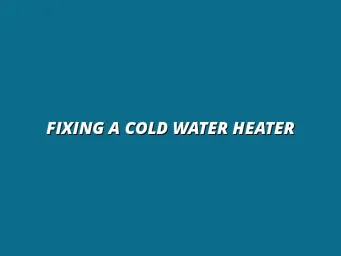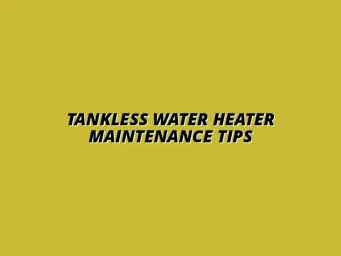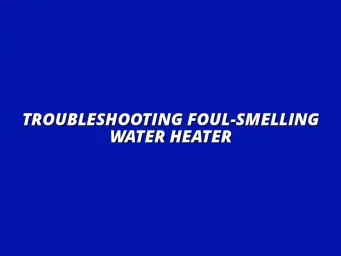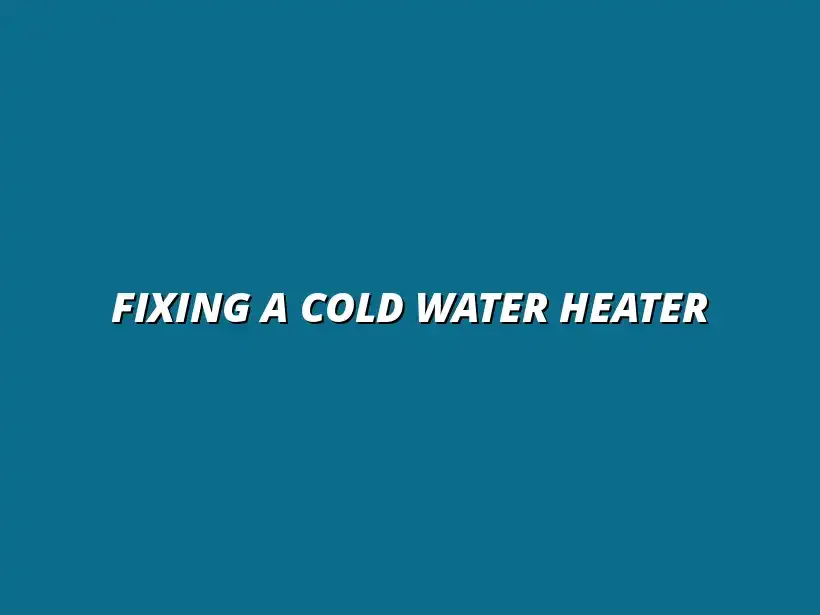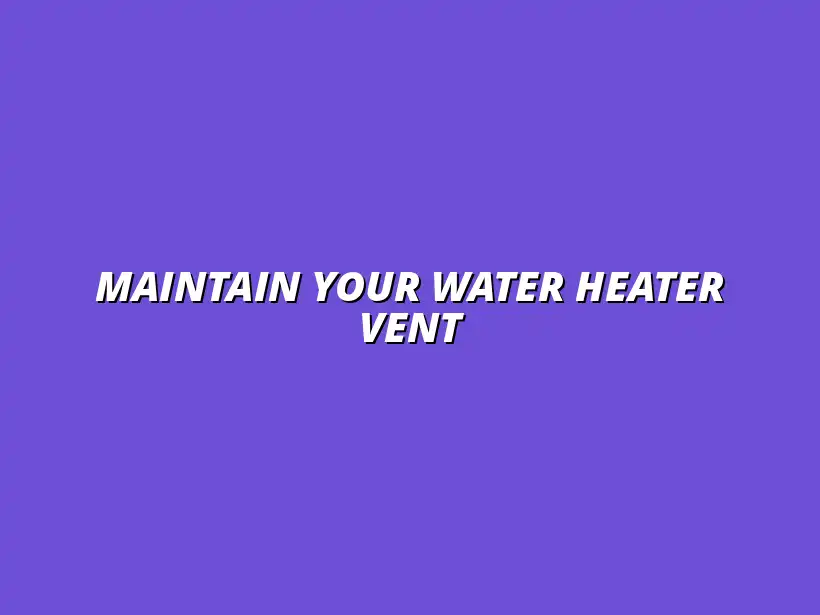
Maintain Your Water Heater Vent
Understanding the Importance of a Clean Water Heater Venting System
A clean water heater venting system is essential for the safe and efficient operation of your water heater. Proper venting allows harmful gases to escape while ensuring a consistent flow of fresh air for combustion. Neglecting this part of your water heater can lead to serious issues, including safety hazards and increased energy costs.
When the venting system is clean and unobstructed, your water heater can function at its best. This means that you'll enjoy consistent hot water, reduced energy bills, and a longer lifespan for your appliance. It's important to recognize the value of regular maintenance to keep everything running smoothly. For more tips on maintaining your water heater, check out this guide on how to easily clean your water heater.
How Venting Affects Water Heater Efficiency
The efficiency of your water heater is directly impacted by its venting system. When vents are clogged or dirty, the heater has to work harder to produce hot water, which can lead to higher energy consumption. In turn, this can cause your utility bills to spike unexpectedly.
Additionally, poor venting can lead to incomplete combustion, resulting in carbon monoxide buildup. This not only poses a health risk but also decreases the overall efficiency of the water heater. To maintain optimal performance, ensure that your venting system is in good condition and free of debris. Understanding plumbing vent systems is key to efficient water heater operation.
- Regular cleaning helps maintain efficiency.
- Proper venting reduces energy costs.
- A clean system promotes safer operation.
Potential Hazards of Neglected Venting Systems
Neglecting your water heater's venting system can lead to serious hazards. One of the most significant risks is the build-up of carbon monoxide, a colorless and odorless gas that can be deadly in high concentrations. Regular maintenance can help prevent this dangerous scenario.
Moreover, a blocked vent can lead to overheating and potential damage to your water heater. This can result in costly repairs or even replacement. Understanding the risks involved helps emphasize the importance of keeping your venting system clean and functional. For more information on preventative maintenance, consider this advice on annual water heater inspections.
- Carbon monoxide buildup risks health and safety.
- Overheating can damage your water heater.
- Ignoring issues can lead to expensive replacements.
Identifying the Components of a Water Heater Venting System
To ensure your water heater functions properly, it's crucial to understand its venting system components. Recognizing each part allows for easier maintenance and troubleshooting. This knowledge can help you spot potential problems before they escalate.
A typical water heater venting system includes several key components that work together. These parts need to be in good condition to ensure safe and efficient operation. Let's explore these essential elements and their roles within the system.
Key Parts of Water Heater Venting Systems
The main components of a water heater venting system include:
- Venting Pipes: These carry exhaust gases away from the heater.
- Vent Hoods: These prevent debris from entering the vent.
- Terminals: These are the openings where gases exit the house.
- Draft Inducers: These help improve airflow through the system.
Each of these parts plays a vital role in ensuring that your water heater operates safely and efficiently. Being familiar with them allows for better maintenance and quicker identification of issues.
Different Types of Venting Systems for Water Heaters
Water heaters can use various venting systems, each with its own advantages and disadvantages. Understanding these systems can help you choose the best one for your home. Here are some of the most common types:
- Natural Venting: Uses gravity and air pressure to vent gases outside.
- Power Venting: Incorporates a fan to push gases out, allowing for longer vent runs.
- Direct Venting: Draws air from outside, creating a sealed system for combustion.
- Atmospheric Venting: Relies on natural draft, typically found in older models.
Choosing the right venting system is crucial for safety and efficiency. Regular flushing is also crucial for maintaining efficiency, learn how to flush your water heater easily here. Make sure to consult with a professional if you're unsure of the best option for your needs!
Best Practices for Ensuring Long-term Safety and Efficiency
Taking care of your water heater venting system is essential for both safety and efficiency. By establishing and following a regular maintenance schedule, you can minimize the risk of issues arising. This proactive approach not only protects your home but also helps your water heater run smoothly for years to come!
To create a solid maintenance schedule, consider factors such as the age of your water heater, local environmental conditions, and usage patterns. Keeping an eye on these factors will help you develop a routine that works for you. Here are some steps to help you establish your schedule:
- Inspect the venting system at least once a year.
- Clean the vent pipes and hoods every six months.
- Replace any damaged or corroded components immediately.
- Check for any signs of blockage or buildup regularly.
Tips for Homeowners to Monitor Venting Health
Monitoring the health of your water heater venting system is an important aspect of home maintenance. For essential kitchen plumbing maintenance tips, check out this helpful guide. Here are some practical tips to help you keep track:
- Keep an eye out for unusual noises, like rattling or whistling.
- Look for signs of rust or corrosion around the venting components.
- Pay attention to any odors, especially gas or burning smells, as these can indicate problems.
- Be aware of any changes in your water heater’s performance, such as longer heating times.
By staying vigilant and following these tips, you can ensure that your water heater venting system maintains optimal performance. Remember, taking action early can prevent costly repairs down the line!
Final Thoughts on Keeping Your Water Heater Venting Safe and Clean
To wrap things up, maintaining a clean and safe water heater venting system is crucial for both efficiency and safety. Regular inspections and cleaning can help prevent serious issues. Here’s a quick recap of the key steps you should follow:
- Inspect your venting system at least annually.
- Clean all components, including vent pipes and hoods, twice a year.
- Replace damaged parts as soon as possible.
- Monitor for any warning signs regularly.
Encouragement to Stay Proactive with Water Heater Care
Taking a proactive approach to your water heater care pays off! By staying engaged with maintenance, you not only secure your home’s safety but also enhance the efficiency of your water heater, saving you money on energy bills. Remember, a little effort today can lead to significant benefits tomorrow!
So, gather your tools and get started on that maintenance schedule. Your water heater will thank you for the attention, and so will your wallet! If you need help unclogging drains, this article on unclogging drains with baking soda might be useful.
Resources for Further Information and Help
If you find yourself needing assistance with your water heater venting system, there are numerous resources available. From professional services to helpful online guides, you have options.
Where to Find Professional Help for Venting Issues
When in doubt, don’t hesitate to reach out for professional help. For plumbing services in Billesley, Birmingham, consider contacting this local plumber. Here are some resources to consider:
- Local plumbing companies specializing in water heater maintenance.
- Online directories like Yelp or Angie's List to find qualified professionals.
- Home improvement stores often provide recommendations for contractors.
Recommended Guides and Tools for Homeowners
For those who prefer a hands-on approach, there are plenty of guides and tools available to assist in your maintenance efforts. Consider these:
- DIY maintenance manuals for water heaters.
- Video tutorials on platforms like YouTube for visual guidance.
- Basic maintenance toolkits available at most home improvement stores.
With the right knowledge and tools, you can confidently take care of your water heater venting system, ensuring it operates safely and effectively for years to come!
